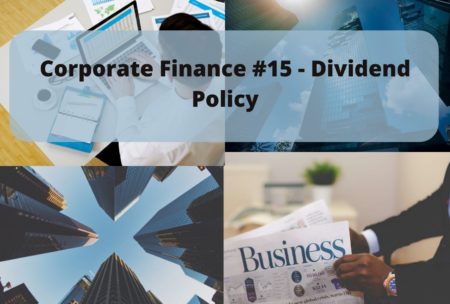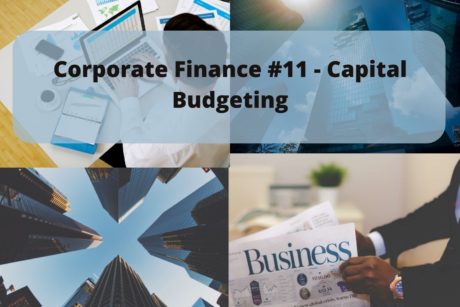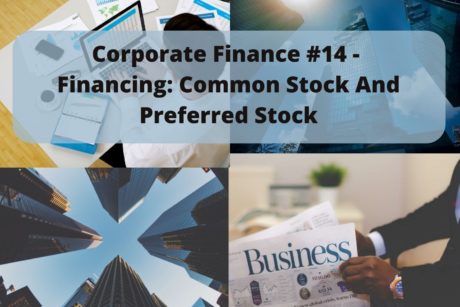Learn about factors involved in corporate dividend policy decisions from a certified public accountant. Read more.
Robert (Bob) Steele CPA, CGMA, M.S. Tax, CPI
Buy this course for $199 $10
and keep lifetime access.
Access all courses in our library for only $9/month with All Access Pass
About This Course
Who this course is for:
- Business students
- Business professionals
What you’ll learn:
- Explain the factors involved when making corporate dividend policy decisions
- Describe dividend policy as it relates to phases in the corporate life cycle
- Discuss the impact shareholders have over dividend policy
- Explain dividend payment terms
- Compare stock dividends and cash dividends
- Describe when a company may use stock dividends
- Discuss the concept of a stock split
- Explain when a company may use a stock split
Requirements:
- Basic understanding of corporate finance concepts
This course will cover corporate dividend policy.
We will include many example problems, both in the format of presentations and Excel worksheet problems. The Excel worksheet presentations will include a downloadable Excel workbook with at least two tabs, one with the answer, the second with a preformatted worksheet that can be completed in a step-by-step process along with the instructional videos.
Dividends represent earnings that a corporation distributes to owners. Dividends for a corporation can be compared to withdrawals from a sole proprietorship or partnership. However, there are substantial differences between a partnership withdrawal and a corporate dividend due to differences in the business structure.
A partner in a partnership generally has more control over the amount of draws they can take and when they can take them. Different partners may also draw different amounts at different times.
By contrast, a corporation must give uniform distributions of dividends to each class of shares, resulting in far less direct control by an individual shareholder to determine the amount of dividends or when they will be distributed.
The dividend distribution policy of a corporation can be very complex, involving many factors, including the life cycle of the company, the cash flow of the company, and the preferences of the shareholders.
A company that is in the growth phase of its life cycle is more likely to have smaller dividends, preferring to reinvest the money to grow operations. Shareholders who would like to invest over a longer time frame may like this policy because the increase in value of the company will increase the value of the shares.
A company in a mature phase of the life cycle may not have as much need to reinvest earnings and is more likely to distribute earnings to shareholders. Many investors like investing in dividend yielding companies because they receive a return on their investment in the form of dividends.
Our Promise to You
By the end of this course, you will have learned corporate dividend policy.
10 Day Money Back Guarantee. If you are unsatisfied for any reason, simply contact us and we’ll give you a full refund. No questions asked.
Get started today and learn more about corporate finance.
Course Curriculum
| Section 1 - Introduction | |||
| Dividend Policy | 00:00:00 | ||
| Other Things That Impact Dividend Policy | 00:00:00 | ||
| Dividend Payment Terms | 00:00:00 | ||
| Stock Dividend | 00:00:00 | ||
| Stock Split | 00:00:00 | ||
| Section 2 - Practice Problems | |||
| Payout Ratio | 00:00:00 | ||
| Payout Ratio, Dividends Per Share, Dividend Yield | 00:00:00 | ||
| Retained Earnings And Dividend Limits | 00:00:00 | ||
| Dividend Projection Life Cycle | 00:00:00 | ||
| Stock Split And Stock Dividend | 00:00:00 | ||
| Dividend Payout Policy Analysis | 00:00:00 | ||
| Annual Dividend Yield, EPS, And Price Earnings Ratio | 00:00:00 | ||
| Earnings Per Share, Dividends Per Share, And Dividend Yield | 00:00:00 | ||
| Ex Dividend Stock Price | 00:00:00 | ||
| Stock Dividend And Cash Dividend Impact On Equity Section | 00:00:00 | ||
| Dividends Vs Investment Analysis | 00:00:00 | ||
| Dividend Policy Impact On Price Or Stock Value | 00:00:00 | ||
| Stock Split 3 For 1 And 2 For 1 | 00:00:00 | ||
| Stock Dividend Impact On Equity And Investor Value | 00:00:00 | ||
| Stock Dividend And Impact On Investor Holdings | 00:00:00 | ||
| Reverse Stock Split | 00:00:00 | ||
| Stock Repurchase Vs Cash Dividend | 00:00:00 | ||
| Dividend Payment Policy | 00:00:00 | ||
| Section 3 - Excel Problems | |||
| Downloadable Course Worksheets | 00:00:00 | ||
| Payout Ratio | 00:00:00 | ||
| Payout Ratio, Dividends Per Share, Dividend Yield | 00:00:00 | ||
| Retained Earnings And Dividend Limits | 00:00:00 | ||
| Dividend Projection Life Cycle | 00:00:00 | ||
| Stock Split And Stock Dividend | 00:00:00 | ||
| Dividend Payout Policy Analysis | 00:00:00 | ||
| Annual Dividend Yield, EPS, And Price Earnings Ratio | 00:00:00 | ||
| Earnings Per Share, Dividends Per Share, And Dividend Yield | 00:00:00 | ||
| Ex Dividend Stock Price | 00:00:00 | ||
| Stock Dividend And Cash Dividend Impact On Equity Section | 00:00:00 | ||
| Dividends Vs Investment Analysis | 00:00:00 | ||
| Dividend Policy On Price Of Stock Valuation | 00:00:00 | ||
| Stock Split 3 For 1 And 2 For 1 | 00:00:00 | ||
| Stock Dividend Impact On Equity And Investor Value | 00:00:00 | ||
| Stock Dividend And Impact On Investor Holdings | 00:00:00 | ||
| Reverse Stock Split | 00:00:00 | ||
| Stock Repurchase Vs Cash Dividend | 00:00:00 | ||
| Dividend Payment Policy | 00:00:00 | ||
About This Course
Who this course is for:
- Business students
- Business professionals
What you’ll learn:
- Explain the factors involved when making corporate dividend policy decisions
- Describe dividend policy as it relates to phases in the corporate life cycle
- Discuss the impact shareholders have over dividend policy
- Explain dividend payment terms
- Compare stock dividends and cash dividends
- Describe when a company may use stock dividends
- Discuss the concept of a stock split
- Explain when a company may use a stock split
Requirements:
- Basic understanding of corporate finance concepts
This course will cover corporate dividend policy.
We will include many example problems, both in the format of presentations and Excel worksheet problems. The Excel worksheet presentations will include a downloadable Excel workbook with at least two tabs, one with the answer, the second with a preformatted worksheet that can be completed in a step-by-step process along with the instructional videos.
Dividends represent earnings that a corporation distributes to owners. Dividends for a corporation can be compared to withdrawals from a sole proprietorship or partnership. However, there are substantial differences between a partnership withdrawal and a corporate dividend due to differences in the business structure.
A partner in a partnership generally has more control over the amount of draws they can take and when they can take them. Different partners may also draw different amounts at different times.
By contrast, a corporation must give uniform distributions of dividends to each class of shares, resulting in far less direct control by an individual shareholder to determine the amount of dividends or when they will be distributed.
The dividend distribution policy of a corporation can be very complex, involving many factors, including the life cycle of the company, the cash flow of the company, and the preferences of the shareholders.
A company that is in the growth phase of its life cycle is more likely to have smaller dividends, preferring to reinvest the money to grow operations. Shareholders who would like to invest over a longer time frame may like this policy because the increase in value of the company will increase the value of the shares.
A company in a mature phase of the life cycle may not have as much need to reinvest earnings and is more likely to distribute earnings to shareholders. Many investors like investing in dividend yielding companies because they receive a return on their investment in the form of dividends.
Our Promise to You
By the end of this course, you will have learned corporate dividend policy.
10 Day Money Back Guarantee. If you are unsatisfied for any reason, simply contact us and we’ll give you a full refund. No questions asked.
Get started today and learn more about corporate finance.
Course Curriculum
| Section 1 - Introduction | |||
| Dividend Policy | 00:00:00 | ||
| Other Things That Impact Dividend Policy | 00:00:00 | ||
| Dividend Payment Terms | 00:00:00 | ||
| Stock Dividend | 00:00:00 | ||
| Stock Split | 00:00:00 | ||
| Section 2 - Practice Problems | |||
| Payout Ratio | 00:00:00 | ||
| Payout Ratio, Dividends Per Share, Dividend Yield | 00:00:00 | ||
| Retained Earnings And Dividend Limits | 00:00:00 | ||
| Dividend Projection Life Cycle | 00:00:00 | ||
| Stock Split And Stock Dividend | 00:00:00 | ||
| Dividend Payout Policy Analysis | 00:00:00 | ||
| Annual Dividend Yield, EPS, And Price Earnings Ratio | 00:00:00 | ||
| Earnings Per Share, Dividends Per Share, And Dividend Yield | 00:00:00 | ||
| Ex Dividend Stock Price | 00:00:00 | ||
| Stock Dividend And Cash Dividend Impact On Equity Section | 00:00:00 | ||
| Dividends Vs Investment Analysis | 00:00:00 | ||
| Dividend Policy Impact On Price Or Stock Value | 00:00:00 | ||
| Stock Split 3 For 1 And 2 For 1 | 00:00:00 | ||
| Stock Dividend Impact On Equity And Investor Value | 00:00:00 | ||
| Stock Dividend And Impact On Investor Holdings | 00:00:00 | ||
| Reverse Stock Split | 00:00:00 | ||
| Stock Repurchase Vs Cash Dividend | 00:00:00 | ||
| Dividend Payment Policy | 00:00:00 | ||
| Section 3 - Excel Problems | |||
| Downloadable Course Worksheets | 00:00:00 | ||
| Payout Ratio | 00:00:00 | ||
| Payout Ratio, Dividends Per Share, Dividend Yield | 00:00:00 | ||
| Retained Earnings And Dividend Limits | 00:00:00 | ||
| Dividend Projection Life Cycle | 00:00:00 | ||
| Stock Split And Stock Dividend | 00:00:00 | ||
| Dividend Payout Policy Analysis | 00:00:00 | ||
| Annual Dividend Yield, EPS, And Price Earnings Ratio | 00:00:00 | ||
| Earnings Per Share, Dividends Per Share, And Dividend Yield | 00:00:00 | ||
| Ex Dividend Stock Price | 00:00:00 | ||
| Stock Dividend And Cash Dividend Impact On Equity Section | 00:00:00 | ||
| Dividends Vs Investment Analysis | 00:00:00 | ||
| Dividend Policy On Price Of Stock Valuation | 00:00:00 | ||
| Stock Split 3 For 1 And 2 For 1 | 00:00:00 | ||
| Stock Dividend Impact On Equity And Investor Value | 00:00:00 | ||
| Stock Dividend And Impact On Investor Holdings | 00:00:00 | ||
| Reverse Stock Split | 00:00:00 | ||
| Stock Repurchase Vs Cash Dividend | 00:00:00 | ||
| Dividend Payment Policy | 00:00:00 | ||




